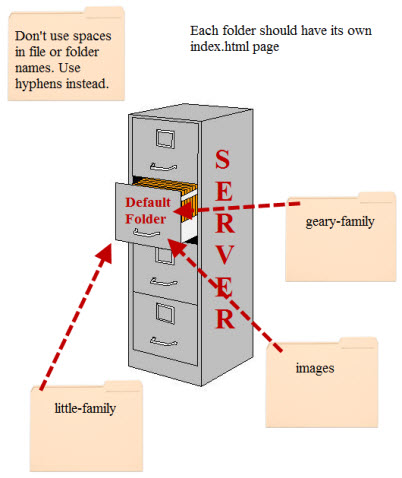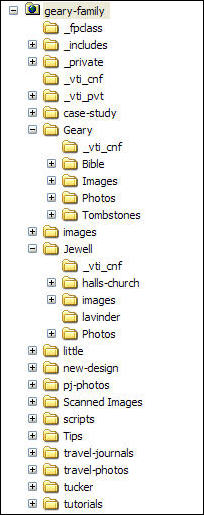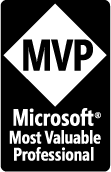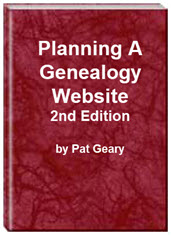- Home
- Resources
- Articles
- Tutorials
- Tutorials & Articles
- Add Search Box
- Converting a Theme Based Site to DWT
- Converting a Table Based Layout
- Create custom Error Pages
- Create 301 Redirects
- Creating a New Website
- Creating a FrontPage Web
- Create a Gradient Image
- Creating Layered Backgrounds
- Creating A Navigation Menu
- Creating Website Navigation
- Heading Tags - <h1> to <h6> tags
- Server Side Includes
- www versus non www
- Using Bordered Backgrounds
- Templates
- Contact

Organize your genealogy website -
Before you can begin to design your pages, you need an organization plan. Get out your paper and pencil and do some initial planning. Sketch out how you think you might layout your site.
- Are you going to put all your files in one directory?
- Are you going to put all of your files in one directory with the exceptions of images which would be in their own directory?
- Are you going to put your files in separate directories with the images in one directory?
- Or will your create separate directories for your files with your images in subdirectories?
If your site is very large and you put everything in one directory, after a while it may be difficult to find things. Spending some time thinking about your organization plan NOW, will save you time and headaches as your site grows.
Organize your site just like you would your filing cabinet. Cheri Zuber has done an excellent job of explaining this using FreePages as an example.

The most important thing to remember when organizing your site is to do it in a way that makes sense to you. You are the one who is going to have to maintain the site and keep track of where you put things. If everything is in one drawer/folder/directory of your file cabinet/server, things will quickly get lost. Reorganizing a website that has not been well thought out and planned can be a very time-consuming and tedious job. Sit down with a paper and pencil and spend some time thinking about the organization of your site. Using the drawing above as an example:
- The file cabinet is your server space – With a paid server you may have one initial drawer public_html where you publish all of your files. In the case of BlueHost, where you can host multiple domains under one account, you can point each domain to its own directory. In my case, I chose family-genealogy-online for my domain family-genealogy-online.com. This domain, genealogy-web-creations.com, resides in a folder genealogy-web-creations. With Rootsweb and the FreePages server, you have a number of communities you can use.
- With each drawer, you can stuff everything in one drawer or organize it by using loose papers (pages), folders (subdirectories) with paper (pages) inside. Again, spend some time thinking about this.
- You may even want folders inside of folders. Each folder/directory should have an index.html page. It may have content on it or it may be blank. You may also be able to set up how a folder with no indext.html file is handled through your control panel.
My genealogy site is about our family genealogy so I need a folder/directory for each of the family lines - two for my husband and two for me. In my root directory, I put all the pages that pertain to the entire site: index.html for the site introduction; site-map.html for the map of the entire site; about-us.html to tell a little about my husband and me. I create a folder for images and one called _includes (more on that later). I also create an image folder under each of the family folders.
I end up with something that looks like this as the outline of my site and the image on the left shows the site as it looks on my computer.

- genealogy (folder where files are uploaded)
- index.html
- about-us.html
- site-map.html
- geary-family
- index.html
- images
- jewel-family
- index.html
- images
- little-family
- index.html
- images
- tucker-family
- index.html
- images
- images (for all images that are used on all pages)
- _includes
The time you spend organizing your site BEFORE you start developing your pages will save you time in the future. You are much less likely to have to go back and reorganize. Now that you have your site organized, decide how you are going to develop your site. What editor will you use?
Download Organizing Your Genealogy Website in pdf format.
Planning a Genealogy Website 2nd Edition is available as a 42 page EBook in pdf format for you to download. It has been totally revised and updated with new content. The EBook is zipped for faster download. Save it to your desktop, extract the file and it is ready to use.

April 2007 - April 2013
Disclosure: This is an affiliate link, which means that if you visit Bluehost.com through this link and purchase this product, I’ll get a commission.
Microsoft® and FrontPage® and Expression Web® are registered trademarks of Microsoft® Corporation.
Genealogy Computer Tips | Expression Web Tutorials & Templates

